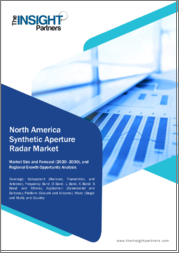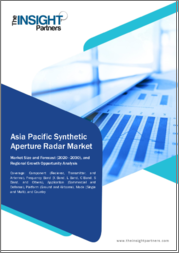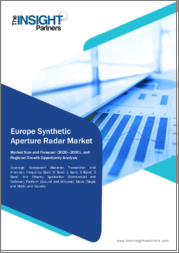
|
시장보고서
상품코드
1567887
북미의 합성 개구 레이더 시장 전망(-2030년) : 지역별 분석 - 부품별, 주파수 대역별, 용도별, 플랫폼별, 모드별 - 북미 시장 전망North America Synthetic Aperture Radar Market Forecast to 2030 - Regional Analysis - by Component, Frequency Band, Application, Platform, and Mode |
||||||
북미의 합성 개구 레이더 시장은 2022년 20억 6,403만 달러, 2030년까지 47억 934만 달러에 달할 것으로 예상되며, 2022-2030년간 연평균 10.9%의 연평균 복합 성장률(CAGR)을 나타낼 것으로 예상됩니다.
고정밀 타겟팅 능력 확보에 대한 관심이 높아지면서 북미의 합성 개구 레이더 시장이 성장하고 있습니다.
차세대 항공기와 AESA(Advanced Electronic Scanning Array) 레이더가 통합되어 여러 대역폭에서 정보를 송수신할 수 있게 되면서 정밀 조준 능력에 대한 선호도가 높아지고 있으며, SAR의 가장 큰 특징 중 하나는 역SAR(ISAR) 이미지를 통해 목표물 정보를 제공할 수 있다는 것입니다. ISAR 기술은 레이더 이미지를 사용하여 표적의 움직임을 추적하고 고해상도 2차원 이미지를 생성합니다. 이 기능은 SAR/ISAR 레이더 이미지를 사용하여 표적을 탐지하고 추적할 수 있기 때문에 정밀 타겟팅에 특히 유용합니다.
정밀 타겟팅은 현대의 전쟁과 감시 활동에서 가장 중요한 요소입니다. SAR은 정확한 표적을 식별하고 추적하는 능력은 군사 및 방위 조직에 매우 중요하며, SAR은 정확한 표적 탐지를 위한 고해상도 이미지 처리 능력을 제공함으로써 이러한 요구를 충족시키는 데 중요한 역할을 하고 있습니다. 정밀한 표적 탐지 능력의 발전은 SAR에 대한 수요를 증가시켜 시장 성장에 긍정적인 영향을 미칠 것으로 예상됩니다. 액티브 전자 스캐닝 어레이(AESA) 레이더의 통합은 X-밴드 및 Ku-밴드 레이더의 사용과 함께 보다 정밀한 표적 탐지를 가능하게 하여 정밀 타겟팅의 전반적인 효과를 높일 수 있습니다. 또한, ISAR 레이더는 해상 순찰기에서 중요한 역할을 수행하여 모든 기상 조건에서 수상 선박 및 기타 물체를 탐지, 이미지화 및 분류할 수 있도록 합니다. 이 능력은 목표물 인식 목적에 매우 중요하며 SAR 시스템에 대한 수요에 기여하고 있습니다.
북미의 합성 개구 레이더 시장 개요
북미의 합성 개구 레이더(SAR) 시장은 미국, 캐나다, 멕시코로 구분됩니다. 국경 보안, 감시, 환경 모니터링, 정부 지출 증가는 예측 기간 동안 합성 개구 레이더에 대한 수요를 창출할 것으로 예상됩니다. 기후 위기로 인해 기온이 상승하고 세계 최대 빙상인 동남극의 빙상이 녹아 해수면이 수 미터 상승할 가능성이 있습니다. 이에 북미 전역의 기관들이 협력하여 빙상, 빙하, 해빙을 포함한 지구의 얼어붙은 지역의 변화를 모니터링하는 합성 개구부 레이더를 개발하기 위해 협력하고 있습니다. 예를 들어, 2024년 1월 미국항공우주국(NASA)과 인도우주연구기구(ISRO)는 공동으로 NASA-ISRO 합성개구레이더(NISAR)를 개발했는데, NISAR는 첨단 레이더 기술을 채택하여 지구의 육지와 얼음 표면의 변화를 모니터링하고 주로 극지방의 빙붕의 동태에 초점을 맞추었습니다. 초점을 맞추었습니다. 이 계획은 동남극 대륙의 위성사진이 빙하 붕괴가 심각하게 진행되고 있어 상세한 모니터링이 시급히 필요하다는 점을 강조하고 있어 중요한 시기를 맞이하고 있습니다.
정부 투자 확대와 군사 및 국방비 증가는 합성 개구 레이더의 성장을 가속하고 있습니다. 또한, 상업적 투자와 정부 투자는 지구관측 위성 및 원격 감지 데이터의 급격한 성장에 선행하고 있습니다. 예를 들어, 2022년 3월 현재, 미군의 연구원들은 Fiddler 프로그램(DARPA-SN-22-23)을 발표하여 합성개구레이더 영상에서 자동 물체 인식을 개선하는 것을 목표로 하고 있으며, SAR의 고유한 영상 처리 능력은 자연재해 후의 변화 감지 및 불법 어업 식별과 같은 긴급 상황에서의 활용에 특히 유용하다, 특히 시시각각 변하는 용도에 유용하게 활용되고 있습니다. 또한, 몇몇 주요 기업들은 상업용 원격 감지 시스템을 위해 합병 및 인수합병과 같은 전략적 이니셔티브를 취하고 있습니다. 예를 들어, 2023년 11월 NASA는 ICEYE의 합성 개구 레이더 데이터를 획득하여 NASA의 지구과학 연구 목표를 달성하기 위한 적합성을 판단하기 위해 과학계와 학계의 평가를 받고 있습니다. 이러한 인수와 개발은 북미의 합성개구레이더 시장 점유율의 성장을 견인하고 있습니다.
북미의 합성 개구 레이더 시장 매출 및 2030년까지의 예측(금액)
북미의 합성 개구 레이더 시장 세분화
북미의 합성 개구 레이더 시장은 부품, 주파수 대역, 응용 분야, 플랫폼, 모드, 국가별로 분류됩니다.
컴포넌트별로 북미의 합성개구레이더 시장은 수신기, 송신기, 안테나로 분류됩니다. 안테나 부문은 2022년 가장 큰 시장 점유율을 차지했습니다.
주파수 대역별로 북미의 합성개구레이더 시장은 x밴드, l밴드, c밴드, s밴드, 기타로 분류되며, 2022년에는 x밴드 부문이 가장 큰 시장 점유율을 차지했습니다.
용도별로 북미의 합성 개구 레이더 시장은 상업용과 방산용으로 구분되며, 2022년 시장 점유율은 방산 분야가 차지할 것으로 예상됩니다.
플랫폼별로 북미의 합성 개구 레이더 시장은 지상용과 공중용으로 나뉘며, 2022년 시장 점유율은 항공기 부문이 차지했습니다.
모드별로 북미의 합성개구레이더 시장은 싱글과 멀티로 나뉘며, 2022년 멀티 시장 점유율이 더 클 것입니다.
국가별로 북미의 합성개구레이더 시장은 미국, 캐나다, 멕시코로 나뉘며, 2022년 북미의 합성개구레이더 시장 점유율은 미국이 독차지했습니다.
Northrop Grumman Corp, BAE Systems Plc, Leonardo SpA, Lockheed Martin Corp, Raytheon Technologies Corp, Thales SA, General Atomics Aeronautical Systems Inc, Saab AB는 북미의 합성 개구 레이더 시장에서 활동하는 주요 기업입니다.
목차
제1장 서론
제2장 개요
- 주요 인사이트
- 시장의 매력
제3장 조사 방법
- 조사 범위
- 2차 조사
- 1차 조사
제4장 북미의 합성 개구 레이더 시장 전망
- 생태계 분석
제5장 북미의 합성 개구 레이더 시장 : 주요 시장 역학
- 시장 성장 촉진요인
- 시장 성장 억제요인
- 시장 기회
- 향후 동향
- 딥러닝(DL)과의 통합
- 성장 촉진요인과 억제요인의 영향
제6장 합성 개구 레이더 시장 : 북미 시장 분석
- 북미의 합성 개구 레이더 시장 매출, 2020년-2030년
- 합성 개구 레이더 시장 예측 분석
제7장 북미의 합성 개구 레이더 시장 분석 - 컴포넌트별
- 수신기
- 송신기
- 안테나
제8장 북미의 합성 개구 레이더 시장 분석 - 주파수대별
- X Band
- L Band
- C Band
- S Band
- 기타
제9장 북미의 합성 개구 레이더 시장 분석 - 용도별
- 상업
- 방위
제10장 북미의 합성 개구 레이더 시장 분석 - 플랫폼별
- 지상
- 낙하산
제11장 북미의 합성 개구 레이더 시장 분석 - 모드별
- 싱글
- 멀티
제12장 북미의 합성 개구 레이더 시장 - 국가별 분석
- 북미 시장 개요
- 북미
- 미국
- 캐나다
- 멕시코
- 북미
제13장 업계 상황 개요
- 시장 이니셔티브
- 제품 개발
- 파트너십과 협업
- 사업 확대
- 기타
제14장 기업 개요
- Northrop Grumman Corp
- BAE Systems Plc
- Leonardo SpA
- Lockheed Martin Corp
- Raytheon Technologies Corp
- Thales SA
- General Atomics Aeronautical Systems Inc
- Saab AB
제15장 부록
LSH 24.10.31The North America synthetic aperture radar market was valued at US$ 2,064.03 million in 2022 and is expected to reach US$ 4,709.34 million by 2030; it is estimated to register a CAGR of 10.9% from 2022 to 2030.
Increasing Preference for Ensuring Precision Targeting Capability Fuels North America Synthetic Aperture Radar Market
The increasing preference for ensuring precision targeting capability is driven by the integration of newer-generation aircraft with advanced electronically scanned array (AESA) radars, which enable the transmission and reception of information on multiple bandwidths. One of the major features of SAR is its ability to provide target information through inverse SAR (ISAR) images. ISAR technology uses radar imaging to generate high-resolution two-dimensional images of a target by tracking its movement. This capability is particularly valuable for precision targeting, as it allows for the detection and tracking of targets using SAR/ISAR radar images.
Precision targeting is of utmost importance in modern warfare and surveillance operations. The ability to accurately identify and track targets is crucial for military and defense organizations. SAR plays a crucial role in fulfilling this need by providing high-resolution imaging capabilities for precise target detection. The rising developments in precision targeting capability are expected to drive the demand for SAR and positively impact market growth. The integration of active electronically scanned array (AESA) radars, along with the use of X-band and Ku-band radars, enables finer target detection and enhances the overall effectiveness of precision targeting. Furthermore, ISAR radars play a significant role in maritime patrol aircraft, allowing for the detection, imaging, and classification of surface ships and other objects in all weather conditions. This capability is crucial for target recognition purposes and contributes to the demand for SAR systems.
North America Synthetic Aperture Radar Market Overview
The North America synthetic aperture radar (SAR) market is segmented into the US, Canada, and Mexico. The increasing border security, surveillance, environmental monitoring, and government spending are anticipated to create demand for synthetic aperture radar during the forecast period. The climate crisis is driving temperatures higher and being the reason for the melting of the world's biggest ice sheet-the East Antarctic, could drive up sea level by many meters. Thus, organizations across North America are collaborating to create synthetic aperture radar to monitor changes in Earth's frozen regions, including ice sheets, glaciers, and sea ice. For instance, in January 2024, the US National Aeronautics and Space Administration (NASA) and the Indian Space Research Organization (ISRO) collaborated to develop the NASA-ISRO Synthetic Aperture Radar (NISAR). NISAR will employ advanced radar technology to monitor changes across Earth's land and ice surfaces, primarily focusing on the dynamics of ice shelves in polar regions. This initiative comes at a crucial time, as satellite imagery from East Antarctica has shown significant glacial collapse, highlighting the urgent need for detailed monitoring.
The growing government investment and increasing military & defense spending empower the growth of synthetic aperture radar. Moreover, commercial and government investments are preceding rapid growth in Earth-observation satellites and remote-sensing data. For instance, as of March 2022, the US military researchers announced the Fiddler program (DARPA-SN-22-23), intended to improve automatic object recognition in synthetic aperture radar images. The unique imaging capability of SAR makes it particularly useful for time-critical applications such as change detection after natural disasters and identifying illegal fishing operations. Further, several key players are taking strategic initiatives such as mergers and acquisitions for commercial remote sensing systems. For instance, in November 2023, NASA acquired ICEYE's synthetic-aperture radar data for evaluation by scientific and academic communities to determine the rightness for advancing NASA's Earth Science research objectives. Thus, such acquisitions and developments propel the growth of the synthetic aperture radar market share in North America.
North America Synthetic Aperture Radar Market Revenue and Forecast to 2030 (US$ Million)
North America Synthetic Aperture Radar Market Segmentation
The North America synthetic aperture radar market is categorized into component, frequency band, application, platform, mode, and country.
Based on component, the North America synthetic aperture radar market is categorized into receiver, transmitter, and antenna. The antenna segment held the largest market share in 2022.
In terms of frequency band, the North America synthetic aperture radar market is categorized into x band, l band, c band, s band, and others. The x band segment held the largest market share in 2022.
By application, the North America synthetic aperture radar market is segmented into commercial and defense. The defense segment held a larger market share in 2022.
Based on platform, the North America synthetic aperture radar market is bifurcated into ground and airborne. The airborne segment held a larger market share in 2022.
In terms of mode, the North America synthetic aperture radar market is bifurcated into single and multi. The multi segment held a larger market share in 2022.
By country, the North America synthetic aperture radar market is segmented into the US, Canada, and Mexico. The US dominated the North America synthetic aperture radar market share in 2022.
Northrop Grumman Corp, BAE Systems Plc, Leonardo SpA, Lockheed Martin Corp, Raytheon Technologies Corp, Thales SA, General Atomics Aeronautical Systems Inc, and Saab AB are some of the leading companies operating in the North America synthetic aperture radar market.
Table Of Contents
1. Introduction
- 1.1 The Insight Partners Research Report Guidance
- 1.2 Market Segmentation
2. Executive Summary
- 2.1 Key Insights
- 2.2 Market Attractiveness
3. Research Methodology
- 3.1 Coverage
- 3.2 Secondary Research
- 3.3 Primary Research
4. North America Synthetic Aperture Radar Market Landscape
- 4.1 Overview
- 4.2 Ecosystem Analysis
5. North America Synthetic Aperture Radar Market - Key Market Dynamics
- 5.1 Market Drivers
- 5.1.1 Increasing Preference for Ensuring Precision Targeting Capability
- 5.1.2 Rising Preference for Integrated C4ISR Ecosystem
- 5.1.3 Growing Demand for Earth Observation and Remote Sensing Capabilities
- 5.2 Market Restraints
- 5.2.1 Satellite Launch Delays
- 5.2.2 High Development Cost
- 5.3 Market Opportunities
- 5.3.1 Rising Development of Dual-Band SAR
- 5.3.2 Increasing Use of SAR in Agriculture Industry
- 5.4 Future Trends
- 5.4.1 Integration with Deep Learning (DL)
- 5.5 Impact of Drivers and Restraints:
6. Synthetic Aperture Radar Market - North America Market Analysis
- 6.1 North America Synthetic Aperture Radar Market Revenue (US$ Million), 2020-2030
- 6.2 Synthetic Aperture Radar Market Forecast Analysis
7. North America Synthetic Aperture Radar Market Analysis - by Component
- 7.1 Receiver
- 7.1.1 Overview
- 7.1.2 Receiver: Synthetic Aperture Radar Market - Revenue and Forecast to 2030 (US$ Million)
- 7.2 Transmitter
- 7.2.1 Overview
- 7.2.2 Transmitter: Synthetic Aperture Radar Market - Revenue and Forecast to 2030 (US$ Million)
- 7.3 Antenna
- 7.3.1 Overview
- 7.3.2 Antenna: Synthetic Aperture Radar Market - Revenue and Forecast to 2030 (US$ Million)
8. North America Synthetic Aperture Radar Market Analysis - by Frequency Band
- 8.1 X Band
- 8.1.1 Overview
- 8.1.2 X Band: Synthetic Aperture Radar Market - Revenue and Forecast to 2030 (US$ Million)
- 8.2 L Band
- 8.2.1 Overview
- 8.2.2 L Band: Synthetic Aperture Radar Market - Revenue and Forecast to 2030 (US$ Million)
- 8.3 C Band
- 8.3.1 Overview
- 8.3.2 C Band: Synthetic Aperture Radar Market - Revenue and Forecast to 2030 (US$ Million)
- 8.4 S Band
- 8.4.1 Overview
- 8.4.2 S Band: Synthetic Aperture Radar Market - Revenue and Forecast to 2030 (US$ Million)
- 8.5 Others
- 8.5.1 Overview
- 8.5.2 Others: Synthetic Aperture Radar Market - Revenue and Forecast to 2030 (US$ Million)
9. North America Synthetic Aperture Radar Market Analysis - by Application
- 9.1 Commercial
- 9.1.1 Overview
- 9.1.2 Commercial: Synthetic Aperture Radar Market - Revenue and Forecast to 2030 (US$ Million)
- 9.2 Defense
- 9.2.1 Overview
- 9.2.2 Defense: Synthetic Aperture Radar Market - Revenue and Forecast to 2030 (US$ Million)
10. North America Synthetic Aperture Radar Market Analysis - by Platform
- 10.1 Ground
- 10.1.1 Overview
- 10.1.2 Ground: Synthetic Aperture Radar Market - Revenue and Forecast to 2030 (US$ Million)
- 10.2 Airborne
- 10.2.1 Overview
- 10.2.2 Airborne: Synthetic Aperture Radar Market - Revenue and Forecast to 2030 (US$ Million)
11. North America Synthetic Aperture Radar Market Analysis - by Mode
- 11.1 Single
- 11.1.1 Overview
- 11.1.2 Single: Synthetic Aperture Radar Market - Revenue and Forecast to 2030 (US$ Million)
- 11.2 Multi
- 11.2.1 Overview
- 11.2.2 Multi: Synthetic Aperture Radar Market - Revenue and Forecast to 2030 (US$ Million)
12. North America Synthetic Aperture Radar Market - Country Analysis
- 12.1 North America Market Overview
- 12.1.1 North America: Synthetic Aperture Radar Market - Revenue and Forecast Analysis - by Country
- 12.1.1.1 North America: Synthetic Aperture Radar Market - Revenue and Forecast Analysis - by Country
- 12.1.1.2 United States: Synthetic Aperture Radar Market - Revenue and Forecast to 2030 (US$ Million)
- 12.1.1.2.1 United States: Synthetic Aperture Radar Market Breakdown, by Component
- 12.1.1.2.2 United States: Synthetic Aperture Radar Market Breakdown, by Frequency Band
- 12.1.1.2.3 United States: Synthetic Aperture Radar Market Breakdown, by Application
- 12.1.1.2.4 United States: Synthetic Aperture Radar Market Breakdown, by Platform
- 12.1.1.2.5 United States: Synthetic Aperture Radar Market Breakdown, by Mode
- 12.1.1.3 Canada: Synthetic Aperture Radar Market - Revenue and Forecast to 2030 (US$ Million)
- 12.1.1.3.1 Canada: Synthetic Aperture Radar Market Breakdown, by Component
- 12.1.1.3.2 Canada: Synthetic Aperture Radar Market Breakdown, by Frequency Band
- 12.1.1.3.3 Canada: Synthetic Aperture Radar Market Breakdown, by Application
- 12.1.1.3.4 Canada: Synthetic Aperture Radar Market Breakdown, by Platform
- 12.1.1.3.5 Canada: Synthetic Aperture Radar Market Breakdown, by Mode
- 12.1.1.4 Mexico: Synthetic Aperture Radar Market - Revenue and Forecast to 2030 (US$ Million)
- 12.1.1.4.1 Mexico: Synthetic Aperture Radar Market Breakdown, by Component
- 12.1.1.4.2 Mexico: Synthetic Aperture Radar Market Breakdown, by Frequency Band
- 12.1.1.4.3 Mexico: Synthetic Aperture Radar Market Breakdown, by Application
- 12.1.1.4.4 Mexico: Synthetic Aperture Radar Market Breakdown, by Platform
- 12.1.1.4.5 Mexico: Synthetic Aperture Radar Market Breakdown, by Mode
- 12.1.1 North America: Synthetic Aperture Radar Market - Revenue and Forecast Analysis - by Country
13. Industry Landscape
- 13.1 Overview
- 13.2 Market Initiative
- 13.3 Product Development
- 13.4 Partnership & Collaboration
- 13.5 Expansion
- 13.6 Others
14. Company Profiles
- 14.1 Northrop Grumman Corp
- 14.1.1 Key Facts
- 14.1.2 Business Description
- 14.1.3 Products and Services
- 14.1.4 Financial Overview
- 14.1.5 SWOT Analysis
- 14.1.6 Key Developments
- 14.2 BAE Systems Plc
- 14.2.1 Key Facts
- 14.2.2 Business Description
- 14.2.3 Products and Services
- 14.2.4 Financial Overview
- 14.2.5 SWOT Analysis
- 14.2.6 Key Developments
- 14.3 Leonardo SpA
- 14.3.1 Key Facts
- 14.3.2 Business Description
- 14.3.3 Products and Services
- 14.3.4 Financial Overview
- 14.3.5 SWOT Analysis
- 14.3.6 Key Developments
- 14.4 Lockheed Martin Corp
- 14.4.1 Key Facts
- 14.4.2 Business Description
- 14.4.3 Products and Services
- 14.4.4 Financial Overview
- 14.4.5 SWOT Analysis
- 14.4.6 Key Developments
- 14.5 Raytheon Technologies Corp
- 14.5.1 Key Facts
- 14.5.2 Business Description
- 14.5.3 Products and Services
- 14.5.4 Financial Overview
- 14.5.5 SWOT Analysis
- 14.5.6 Key Developments
- 14.6 Thales SA
- 14.6.1 Key Facts
- 14.6.2 Business Description
- 14.6.3 Products and Services
- 14.6.4 Financial Overview
- 14.6.5 SWOT Analysis
- 14.6.6 Key Developments
- 14.7 General Atomics Aeronautical Systems Inc
- 14.7.1 Key Facts
- 14.7.2 Business Description
- 14.7.3 Products and Services
- 14.7.4 Financial Overview
- 14.7.5 SWOT Analysis
- 14.7.6 Key Developments
- 14.8 Saab AB
- 14.8.1 Key Facts
- 14.8.2 Business Description
- 14.8.3 Products and Services
- 14.8.4 Financial Overview
- 14.8.5 SWOT Analysis
- 14.8.6 Key Developments
15. Appendix
- 15.1 About The Insight Partners
- 15.2 Word Index



















